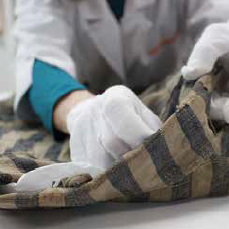
What’s Embedded in Once-Ordinary Objects Brushed by Violence?

It was early august when I took the Metro out to a suburban station to meet the chief conservator of the United States Holocaust Memorial Museum (USHMM). She was taking me to the museum’s off-site storage facility. I would spend the day in this most unlikely space. As I entered the nondescript suburban building—the museum’s off-site repository had not yet moved into its new state-of- the art facility—I was struck by its bland character, a deliberate choice. This was my impression until I entered the first of many rooms and, eventually, the vast storage space that housed so much of the museum’s collection.
In that first room, a conservation space, I watched a woman seated beside an ironing board, sewing intently. She was working on a damaged blue-andwhite- striped prisoner uniform. I had never been this close to one of these iconic garments. I thought about the uniforms I had seen on display and those I had seen in photographs. This jacket was much more elaborate than any I had ever seen. It was carefully tailored with many seams and pockets, but it was also in terrible shape. There were huge holes and tears in it (why is this word the same as tears?). These wounds were the focus of the seamstress’s careful attention. The room was electric with the energy that crackled from this fragile object, and I was deeply affected by the experience.
I find myself homing in to consider clothing and other material objects as much more intimate. These are objects that cover and hold our bodies. We wear these textiles. We live inside them. The longer we inhabit them, the more of us they contain; skin cells, sweat, piss, blood, saliva, tears, permeate such garments. But clothing that is worn day in and day out for long periods of time is also marked in a different way. It is shaped by our bodies. Not only were these uniforms worn constantly, but because they were handed out haphazardly, they often did not fit, and so were carefully tailored by the very prisoners who wore them, who used whatever was at hand to try to make them fit. The uniform jacket I saw being mended was unusual in its intricate tailoring. It was altered to fit a specific person.
The camp uniforms held in the USHMM collection are so fragile that careful efforts must be made simply to keep them from disintegrating. And because the bodies of those who inhabited these garments have been missing for so long, in order to preserve them, to keep them from falling apart, each uniform has its own body-shaped hanger. These effigies are custom fit. They are specially made for each jacket, shirt, or pair of pants. These stuffed, mannequin-like hanging figures help take the stress off fragile seams and frayed panels. The prisoners are gone but the hangers convey a semblance of their presence. In reverse logic, the bodies beneath the fabric protect the garment, not the other way around. Because these pieces of clothing are also witnesses to the atrocities performed on those who wore them, they attest to those crimes. They constitute a form of criminal as well as historical evidence. Bound to those bodies and those legacies, they offer silent testimony, but their presence in the museum is not simply material.
An aura emanates from these intimate articles of clothing. Once an abiding presence in the lives of those who wore them, these garments carry the traces of those now absent bodies.
The striped uniform, the bloody hoody, each allows us to stitch connections between ourselves and these different violent legacies. Abiding affective engagements reside in these tattered objects. Such objects keep the event tangible, suspended, and within our reach.
Atlanta, November 1989
Early in the evening on the first Tuesday in November, 1989, I was raped in my home in Atlanta, Georgia. As it turned out, this happened just as the Berlin Wall was about to fall. A strange man broke into my home, hid, and then attacked me. I screamed, and this only exacerbated his rage. He choked me. And then he raped me in my own bed. He threatened to kill me.
At the time, I was a graduate student at Emory completing my doctoral studies in religion. After the police finally arrived on the scene—itself a protracted and exasperating experience—they began to ask questions and collect evidence. But I need to say that the police came late, too late to apprehend the suspect. Not only had I waited on hold with 911 until I finally got through to the police, but I later learned that my landlady, having heard my cries, had also called the police to no avail. She too could not get through to report the crime in process. This is a gap in time I still cannot fully fathom. By the time the police arrived, the man was long gone.
I was taken to Grady Hospital for a rape exam only after the Atlanta police had combed the scene for evidence. They took the comforter and some of the sheets that had been on my bed, and after the rape exam at the hospital, I believe, they also took possession of various pieces of my clothing, including my sweatpants and underwear.
But here my memory falters. I hardly remember the order of these events or what the police took. What I do know is that once they left, I threw away the rest of the clothing I had been wearing. I placed these items in a dumpster outside the hospital. At least this is how I remember it, although none of these items appear in any police documents.
None of my possessions are listed in the inventory from the crime scene, for example, on the official police report. To date, nothing has been found, neither the evidence procured from my rape kit nor any of the clothing or bedding taken from my home and my person that night. I do not know what happened to any of them. Nor do I know whether my rape kit was ever processed. That information cannot be verified. I can only assume that it was not.
Nevertheless, even as I have learned that these possessions are no longer accessible, I am moved by my memory, by the imprint of these once tactile everyday objects on how I think about this past and the fact that I had for so many years forgotten all about them.
Held in such material containers, the trauma is made concrete. These tangible objects testify to the fact that these events are not a figment of the imagination. They are one important way we know that these events actually happened, that this is not a dream.
Laura Levitt is a Professor of Religion, Jewish Studies and Gender at Temple University. Her new book, The Objects That Remain is both a personal memoir and examination of the ways in which the material remains of violent crimes inform our experience of, and thinking about, trauma and loss.



